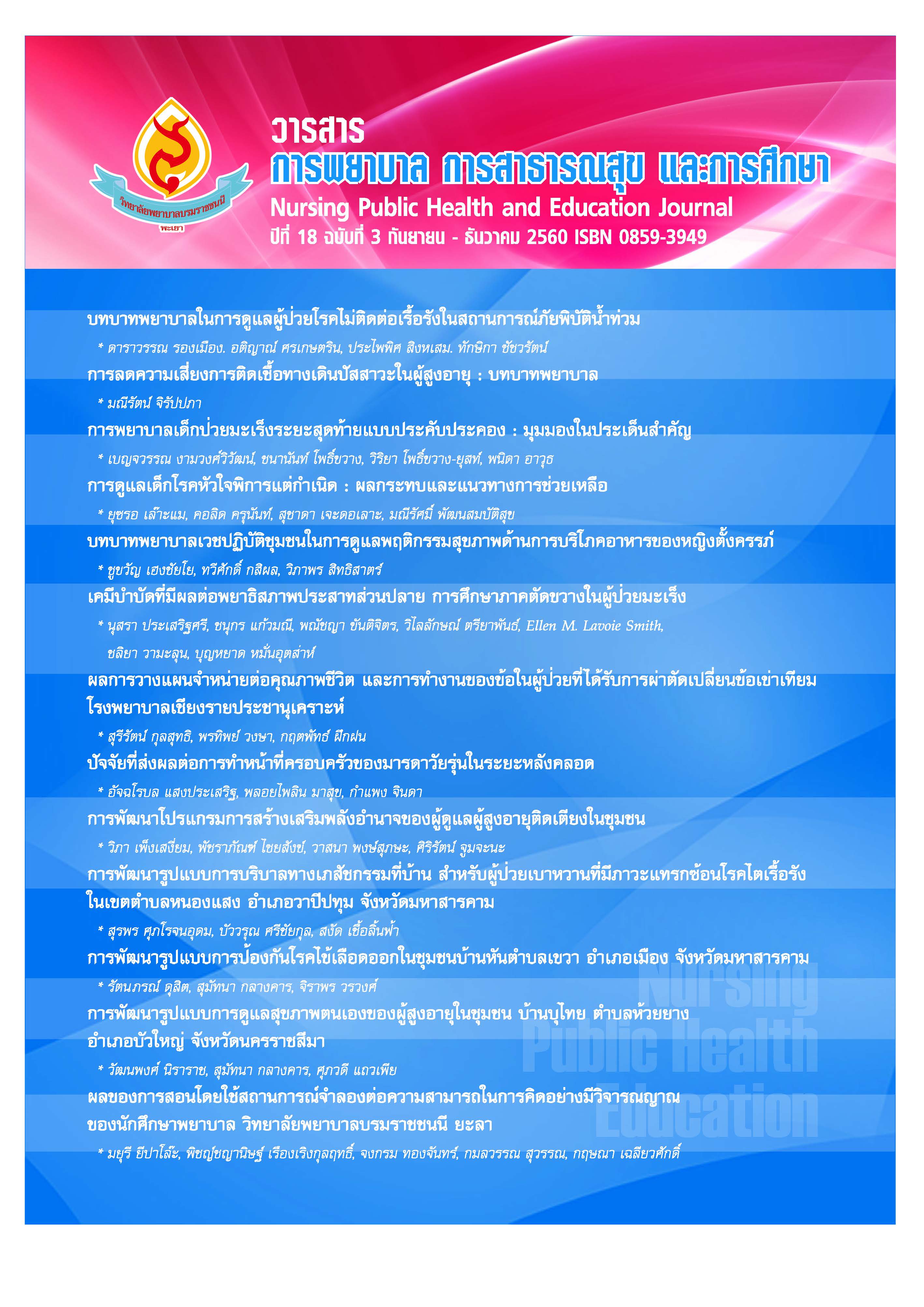การพัฒนารูปแบบการป้องกันโรคไข้เลือดออกในชุมชนบ้านหัน ตำบลเขวา อำเภอเมือง จังหวัดมหาสารคาม The Development of Preventive Model of Dengue Haemorrhagic Fever at Community Level in Hun Village, khwao Sub-District, Maung District, Mahasarakham Province
คำสำคัญ:
การพัฒนารูปแบบ, การป้องกันโรค, นโยบายสาธารณะ, Development, Prevention, Public Policyบทคัดย่อ
โรคไข้เลือดออกเป็นโรคติดต่อจากเชื้อไวรัสที่มียุงลายเป็นพาหะซึ่งเป็นปัญหาสาธารณสุขของประเทศมายาวนาน การวิจัยครั้งนี้เป็นการวิจัยเชิงปฏิบัติการ (Action Research) มีความมุ่งหมายเพื่อพัฒนารูปแบบการป้องกันโรคไข้เลือดออกในชุมชนบ้านหัน ศึกษาในกลุ่มเป้าหมายที่เลือกตามเกณฑ์จาก 3 ภาคส่วน ได้แก่ ภาคประชาชน 40 คน ภาคการเมือง 8 คน ภาควิชาการ 4 คน และกลุ่มตัวอย่างที่คัดเลือกแบบเจาะจงจากประชาชน 23 คน รวมทั้งหมด 75 คน การศึกษานี้มีขั้นตอนการดำเนินงาน 8 ขั้นตอน คือ 1) ศึกษาบริบท 2) วิเคราะห์สถานการณ์ 3) จัดประชุมคณะกรรมการ 4) ปฏิบัติตามแผนปฏิบัติการ 5) นิเทศติดตาม 6) ประเมินผลการดำเนินงาน 7) จัดเวทีแลกเปลี่ยนเรียนรู้ และ 8) ถอดบทเรียน การวิเคราะห์ข้อมูลเชิงปริมาณโดยสถิติเชิงพรรณนา ได้แก่ ความถี่ ร้อยละ ค่าเฉลี่ย และส่วนเบี่ยงเบนมาตรฐาน และข้อมูลเชิงคุณภาพโดยการวิเคราะห์เนื้อหา ผลการศึกษาพบว่า รูปแบบและแนวทางการป้องกันโรคไข้เลือดออกในชุมชนโดยเกิดจากการมีส่วนร่วมของชุมชน เกิดโครงการ 4 โครงการ ได้แก่ 1) โครงการอบรมให้ความรู้เรื่องโรคไข้เลือดออก 2) โครงการหมู่บ้านน่าอยู่ น่ามอง 3) โครงการคัดแยกขยะ 4) โครงการรณรงค์หมู่บ้านชุมชนตำบลปลอดลูกน้ำยุงลายปลอดโรคไข้เลือดออก และ 3 กิจกรรม ได้แก่ 1) นโยบายสาธารณะการป้องกันโรคไข้เลือดออกในชุมชนบ้านหัน 2) การมีข้อบังคับหมู่บ้านหรือข้อตกลงประชาคมหมู่บ้านเกี่ยวกับการดำเนินงานการป้องกันโรคไข้เลือดออก 3) มีการออกข้อบัญญัติตำบลเรื่อง การควบคุมแหล่งเพาะพันธุ์ยุงลาย พ.ศ. 2559 ผลการดำเนินงานส่งผลให้ภาคีเครือข่ายที่สำคัญในชุมชน คือ ภาคประชาชน ภาคการเมือง ภาควิชาการและภาคีเครือข่ายต้องทำงานร่วมกันและพร้อมขับเคลื่อนนโยบายสาธารณะของชุมชน แนวทางดังกล่าวส่งผลให้ในชุมชนมีลูกน้ำยุงลายที่เป็นพาหะของโรคลดลง โดยสรุป ปัจจัยความสำเร็จในการดำเนินงาน คือ กลวิธีสร้างความร่วมมือจากประชาชนและภาคีเครือข่ายในชุมชน ซึ่งเป็นแนวทางที่เหมาะสมกับบริบทของชุมชนและเกิดการพัฒนาที่ยั่งยืนโดยชุมชนเอง
คำสำคัญ : การพัฒนารูปแบบ การป้องกันโรค นโยบายสาธารณะ
Dengue Haemorrhagic Fever is one of the most important infectious diseases in Thailand for many decades. This led to the research on the development of Dengue Haemorrhagic fever at Community Level in Hun Village, khwao Sub-District, Maung District, Mahasarakham Province. The participants sampling recruited 3 purposive groups sector namely the community population (40 person) the political personnel sector (8 person) and the academic sector personnel (4 person). The samples were 75 participants purposively selected from the communities. There were eight steps: 1) Educational context, 2) Analysis, 3) The Board of Directors, 4) Follow the Action Plan, 5) Supervision, 6) Evaluation, 7) Organize the exchange of learning, 8) Quantitative data analysis using descriptive statistics, percentage, average, standard deviation. Minimum Maximum and qualitative content analysis. The study shows that the new model of Dengue Haemorrhagic fever in the participated workshop by 4 new projects including 1: A project for giving the knowledge of the Haemorrhagic fever disease. 2: A project of livable, attractive for living and Healthy village. 3: A project for the effective trash management village. 4: A project for campaign against the mosquito larva, the carrier of Haemorrhagic fever disease and the 3 activites are 1: A project of using the public policy for prevention the Haemorrhagic fever disease. 2: A project for issuing the guideline or agreement concerning the practical performance of prevention of Haemorrhagic fever disease. 3: Establish and issuing the sub-district rule for controlling the environmental resources where the mosquito can be spread and breeding. The successful outcome of developing preventive model of Dengue Haemorrhagic fever is formed by the participation, part politics and department academic by party network interoperability and be powered by public Policy after launching this project, the indication of masquito lave were decreased that observed by the low level of container index (CI) In summary, the key success requires cooperation and support and from networks in the community. The model based-community context was developed.
Key Word : Development, Prevention, Public Policy



